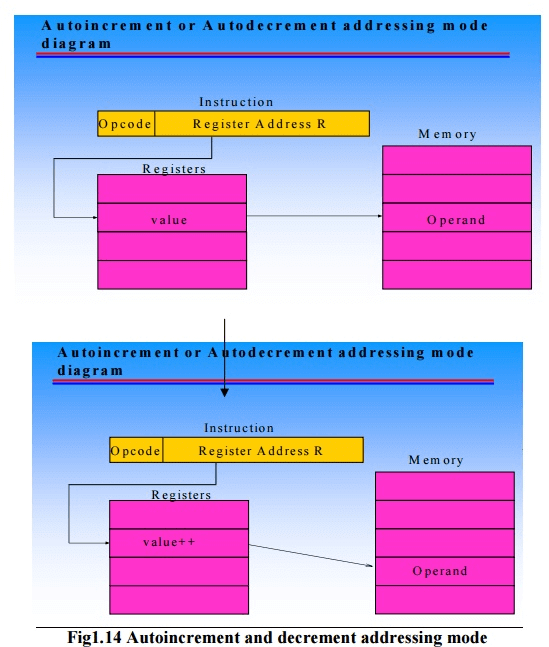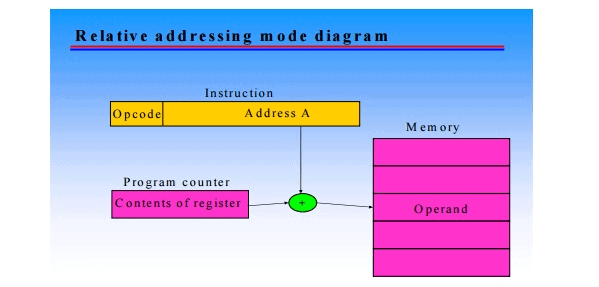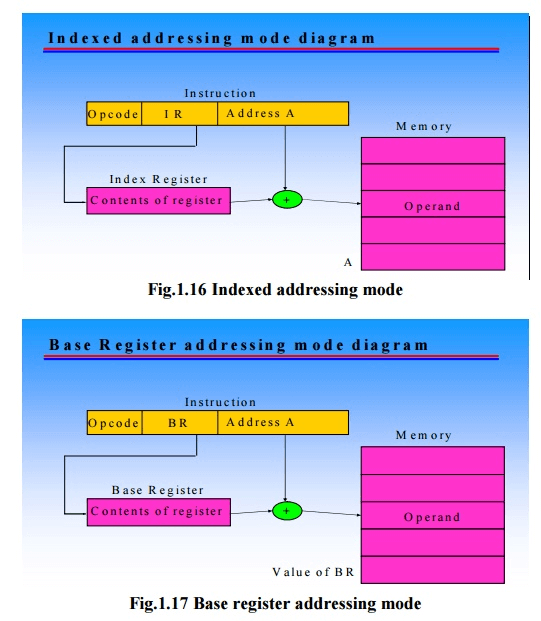Addressing and Addressing Modes - Instructions, Computer Science and IT Engineering - Computer Science Engineering (CSE) PDF Download
Computer Architecture: Addressing and Addressing Modes
To perform any operation, the corresponding instruction is to be given to the microprocessor. In each instruction, programmer has to specify 3 things:
- Operation to be performed.
- Address of source of data.
- Address of destination of result.
ADDRESSING AND ADDRESSING MODES
To perform any operation, the corresponding instruction is to be given to the microprocessor. In each instruction, programmer has to specify 3 things:
- Operation to be performed.
- Address of source of data.
- Address of destination of result.
Definition:
- The different ways in which the location of an operand is specified in an instruction are referred to as addressing modes.
- The method by which the address of source of data or the address of destination of result is given in the instruction is called Addressing Modes
- Computers use addressing mode techniques for the purpose of accommodating one or both of the following provisions:
- To give programming versatility to the user by providing such facilities as pointers to memory, counters for loop control, indexing of data, and program relocation.
- To reduce the number of bits in the addressing field of the instruction.
IMPLEMENTATION OF VARIABLES AND CONSTANTS
Variables and constants are the simplest data types and are found in almost every computer program. A variable is represented by allocating a register or a memory location to hold its value. Thus, the value can be changed as needed using appropriate instructions.
1. Register addressing mode - The operand is the contents of a processor register; the name (address) of the register is given in the instruction.
Example: MOVE R1,R2
This instruction copies the contents of register R2 to R1.
2. Absolute addressing mode - The operand is in a memory location; the address of this location is given explicitly in the instruction. (In some assembly languages, this mode is called Direct.)
Example: MOVE LOC,R2
This instruction copies the contents of memory location of LOC to register R2.
3. Immediate addressing mode - The operand is given explicitly in the instruction.
Example: MOVE #200 , R0
The above statement places the value 200 in the register R0. A common convention is to use the sharp sign (#) in front of the value to indicate that this value is to be used as an immediate operand.
INDIRECTION AND POINTERS
In the addressing modes that follow, the instruction does not give the operand or its address explicitly. Instead, it provides information from which the memory address of the operand can be determined. We refer to this address as the effective address (EA) of the operand.
4. Indirect addressing mode
The effective address of the operand is the contents of a register or memory location whose address appears in the instruction.
Example Add (R2),R0
Register R2 is used as a pointer to the numbers in the list, and the operands are accessed indirectly through R2. The initialization section of the program loads the counter value n from memory location N into Rl and uses the Immediate addressing mode to place the address value NUM 1, which is the address of the first number in the list, into R2.
INDEXING AND ARRAY
It is useful in dealing with lists and arrays.
5. Index mode
The effective address of the operand is generated by adding a constant value to the contents of a register. The register used may be either a special register provided for this purpose, or, more commonly; it may be anyone of a set of general-purpose registers in the processor. In either case, it is referred to as an index register. We indicate the Index mode symbolically as
X(Ri).
Where X denotes the constant value contained in the instruction and Ri is the name of the register involved. The effective address of the operand is given by EA = X + [Ri]. The contents of the index register are not changed in the process of generating the effective address.
RELATIVE ADDRESSING
An useful version of this mode is obtained if the program counter, PC, is used instead of a general purpose register. Then, X(PC) can be used to address a memory location that is X bytes away from the location presently pointed to by the program counter. Since the addressed location is identified ''relative'' to the program counter, which always identifies the current execution point in a program, the name Relative mode is associated with this type of addressing.
6.Relative mode - The effective address is determined by the Index mode using the program counter in place of the general-purpose register Ri. This mode can be used to access data operands. But, its most common use is to specify the target address in branch instructions. An instruction such as Branch>O LOOPcauses program execution to go to the branch target location identified by the name LOOP if the branch condition is satisfied. This location can be computed by specifying it as an offset from the current value of the program counter. Since the branch target may be either before or after the branch instruction, the offset is given as a signed number.
ADDITIONAL MODES
The two additional modes described are useful for accessing data items in successive locations in the memory.
7. Autoincrement mode - The effective address of the operand is the contents of a register specified in the instruction. After accessing the operand, the contents of this register are automatically incremented to point to the next item in a list. We denote the Autoincrement mode by putting the specified register in parentheses, to show that the contents of the register are used as the effective address, followed by a plus sign to indicate that these contents are to be incremented after the operand is accessed. Thus, the Autoincrement mode is written as (Ri) +. As a companion for the Autoincrement mode, another useful mode accesses the items of a list in the reverse order:
8. Autodecrement mode - The contents of a register specified in the instruction is first automatically decremented and is then used as the effective address of the operand. We denote the Autodecrement mode by putting the specified register in parentheses, preceded by a sign to indicate that the contents of the register are to be decremented before being used as the effective address. Thus, we write - (Ri)

Illustration of Addressing Modes
- Implied addressing mode
- Immediate addressing mode
- Direct addressing mode
- Indirect addressing mode
- Register addressing mode
- Register Indirect addressing mode
- Autoincrement or Autodecrement addressing mode
- Relative addressing mode
- Indexed addressing mode
- Base register addressing mode
- Implied addressing mode
In this mode the operands are specified implicitly in the definition of the instruction. For example the ‘complement accumulator’ instruction is an implied mode instruction because the operand in the accumulator register is implied in the definition of the instruction itself. All register reference instructions that use an accumulator are implied mode instructions. Zero address instructions in a stack organized computer are implied mode instructions since the operands are implied to be on the top of the stack.
Example : CMA
Immediate addressing mode

Fig. 1.9 Immediate addressing mode
In this mode the operand is specified in the instruction itself. In other words, an immediate mode instruction has a operand field rather than an address field. The operand field contains the actual operand to be used in conjunction with the operation specified in the instruction. Immediate mode instructions are useful for initializing registers to a constant value.
Example: ADD 5
- Add 5 to contents accumulator of
- 5 is operand
Advantages and disadvantages
- No memory reference to fetch data
- Fast
- Limited range
Direct addressing mode
In this mode the effective address is equal to the address part of the instruction. The operand resides in memory and its address is given directly by the address field of instruction. In a branch type instruction the address field specifies the actual branch address
Effective address (EA) = address field (A)

Fig. 1.10 Direct addressing mode
e.g. LDA A
Look in memory at address A for operand.
Load contents of A to accumulator
Advantages and disadvantages
- Single memory reference to access data
- No additional calculations to work out effective address
- Limited address space
Indirect addressing mode
In this mode the address field of the instruction gives the address where the effective address is stored in memory/register. Control fetches the instruction from memory and uses its address part to access memory again to read the effective address.
EA = address contained in register/memory location

Fig. 1.11 Indirect addressing mode
Example Add (M)
- Look in M, find address contained in M and look there for operand
- Add contents of memory location pointed to by contents of M to accumulator
Register addressing mode
In this mode the operands are in the registers that reside within the CPU.
EA = R
Example : ADD R1,R2
Advantages and disadvantages
- No memory access. So very fast execution.
- Very small address field needed.
- Shorter instructions
- Faster instruction fetch
- Limited number of registers.
- Multiple registers helps performance
- Requires good assembly programming or compiler writing
Register indirect addressing mode
In this mode the instruction specifies a register in the CPU whose contents give the effective address of

Fig.1.12 Register addressing mode
the operand in the memory. In other words, the selected register contains the address of the operand rather than the operand itself. Before using a register indirect mode instruction, the programmer must ensure that the memory address of the operand is placed in the processor register with a previous instruction. The advantage of a register indirect mode instruction is that the address field of the instruction uses fewer bits to select a register than would have been required to specify a memory address directly.
Therefore EA = the address stored in the register R
- Operand is in memory cell pointed to by contents of register
- Example Add (R2),R0
Advantage
- Less number of bits are required to specify the register.
- One fewer memory access than indirect addressing.
Register Indirect addressing mode diagram

Fig. 1.13 Indirect addressing mode
Autoincrement or autodecrement addressing mode
Autoincrement mode - The effective address of the operand is the contents of a register specified in the instruction. After accessing the operand, the contents of this register are automatically incremented to point to the next item in a list.
- We denote the Autoincrement mode by putting the specified register in parentheses, to show that the contents of the register are used as the effective address, followed by a plus sign to indicate that these contents are to be incremented after the operand is accessed. Thus, the Autoincrement mode is written as (Ri) +
Autodecrement mode - The contents of a register specified in the instruction is first automatically decremented and is then used as the effective address of the operand.
We denote the Autodecrement mode by putting the specified register in parentheses, preceded by a minus sign to indicate that the contents of the register are to be decremented before being used as the effective address. Thus, we write - (Ri)
- These two modes are useful when we want to access a table of data
ADD (R1)+
will increment the register R1.
LDA -(R1)
will decrement the register R1.
Relative addressing mode
In this mode the content of the program counter is added to the address part of the instruction in order to obtain the effective address. Effective address is defined as the memory address obtained from the computation dictated by the given addressing mode. The address part of the instruction is usually a signed number (in 2’s complement representation) which can be either positive or negative. When this number is added to the content of the program counter, the result produces an effective address whose position in memory is relative to the address of the next instruction.
Relative addressing is often used with branch type instructions when the branch address is in the area surrounding the instruction word itself. It results in a shorter address field in the instruction format since the relative address can be specified with a smaller number of bits compared to the bits required to designate the entire memory address.
EA = A + contents of PC
Example: PC contains 825 and address pa rt of instruction contains 24.
After the instruction is read from location 825, the PC is incremented to 826. So EA=826+24=850. The operand will be found at location 850 i.e. 24 memory locations forward from the address of the next instruction.


Fig.1.15 Relative addressing mode
Indexed addressing mode
In this mode the content of an index register is added to the address part of the instruction to obtain the effective address. The index register is a special CPU register that contains an index value. The address field of the instruction defines the beginning address of a data array in memory. Each operand in the array is store din memory relative to the beginning address. The distance between the beginning address and the address of the operand is the index value stored in the index register. Any operand in the array can be accessed with the same instruction provided that the index register contains the correct index value. The index register can be incremented to facilitate access to consecutive operands. Note that if an index type instruction does not include an address field in its format, then the instruction converts to the register indirect mode of operation.
- Therefore EA = A + IR
- Example MOV AL , DS: disp [SI] Advantage
- Good for accessing arrays.
Base register addressing mode
In this mode the content of base register is added to the address part of the instruction to obtain the effective address. This is similar to the indexed addressing mode except that the register is now called a base register instead of an index register. The difference between the two modes is in the way they are used rather than in the way that they are computed.
An index register is assumed to hold an index number that is relative to the address part of the instruction. A base register is assumed to hold a base address and the address field of the instruction gives a displacement relative to this base address. The base register addressing mode is used in computers to facilitate the relocation of the programs in memory. When programs and data are moved from one segment of memory to another, as required in multiprogramming systems, the address values of instructions must reflect this change of position. With a base
register, the displacement values of instructions do not have to change. Only the value of the base register requires updating to reflect the beginning of a new memory segment.

• Therefore EA= A + BR
• For example: MOV AL, disp [BX]
Segment registers in 8086
MIPS Addressing Mode Summary
1. Immediate addressing, where the operand is a constant within the instruction itself
2. Register addressing, where the operand is a register
3. Base or displacement addressing, where the operand is at the memory location whose address is the sum of a register and a constant in the instruction
4. PC-relative addressing, where the branch address is the sum of the PC and a constant in the instruction
5. Pseudodirect addressing, where the jump address is the 26 bits of the instruction concatenated with the upper bits of the PC
FAQs on Addressing and Addressing Modes - Instructions, Computer Science and IT Engineering - Computer Science Engineering (CSE)
| 1. What is the purpose of addressing in computer science and IT engineering? |  |
| 2. What are the different addressing modes used in computer science and IT engineering? |  |
| 3. How do instructions in computer science and IT engineering use addressing modes? |  |
| 4. Why is understanding addressing and addressing modes important in computer science and IT engineering? |  |
| 5. What are some common challenges or issues related to addressing and addressing modes in computer science and IT engineering? |  |

|
Explore Courses for Computer Science Engineering (CSE) exam
|

|


















